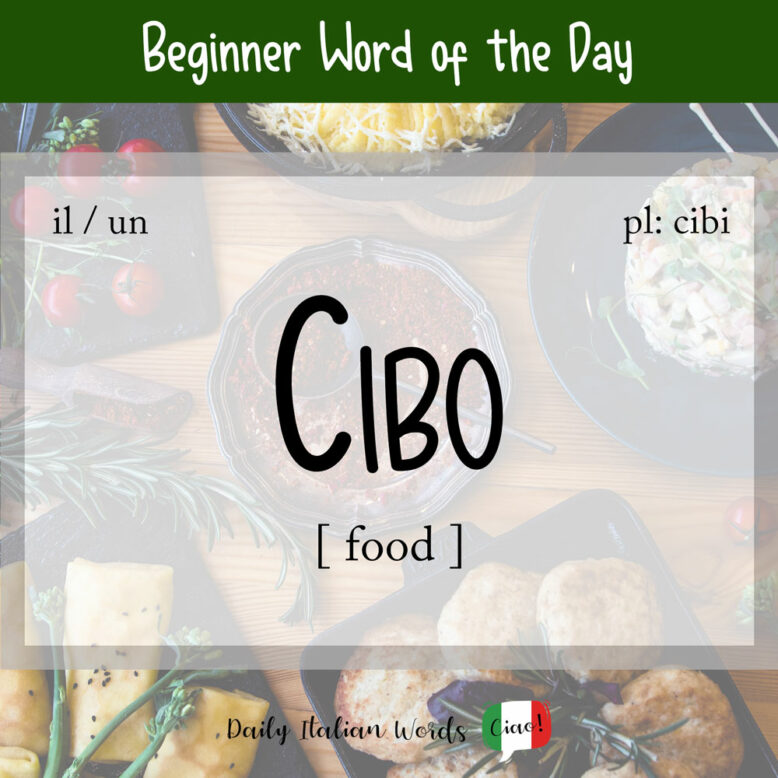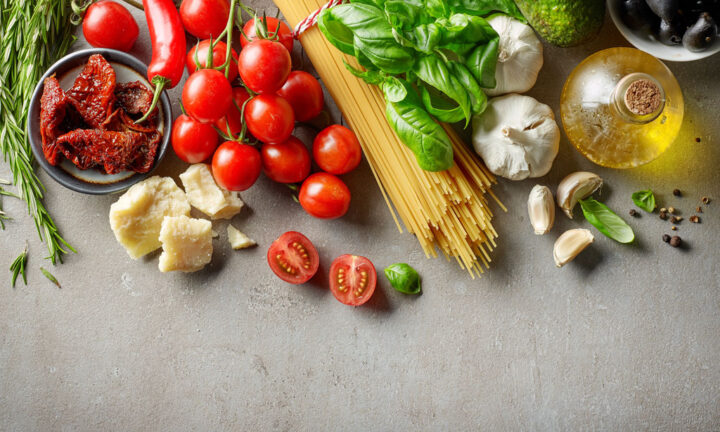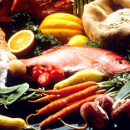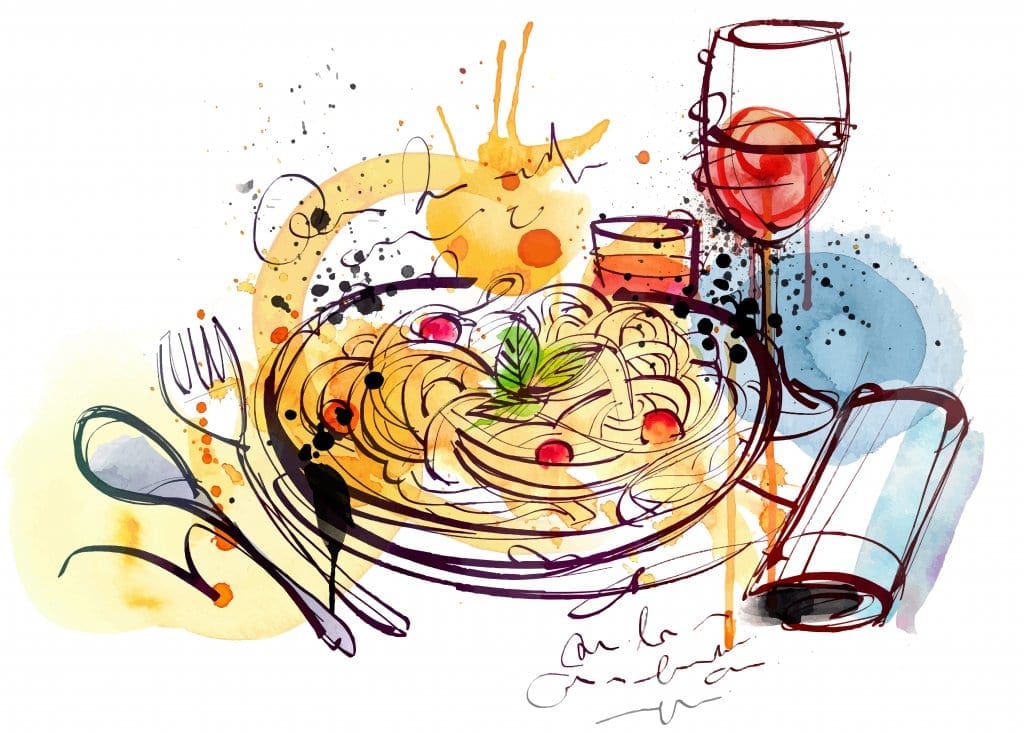Today we’re going to be looking at the most common and colloquial term for food in Italian: cibo (masculine, plural: cibi). Derived from the Latin cibus meaning food, it refers to any nutritious substance that living organisms eat or drink.

In Italy, life revolves around the preparation and enjoyment of good food (cibo buono / buon cibo). Most traditional meals consist of simple ingredients such as pasta, rice, tomatoes, garlic, olive oil, ham and various cheeses which, when combined, result in dishes destined to delight the senses. Rare is it to meet an Italian mother who cooks bad food (cibo cattivo), and rarer still is it to encounter an Italian who will accept poor cooking without a word of complaint!
Ho una passione per il buon cibo italiano.
I have a passion for good Italian food.

There are numerous adjectives you can use to describe the quality of food in Italian besides just buono (good) and cattivo (bad). Let’s take a look at a few of them now!
- cibo pesante = heavy food
- cibo piccante = spicy food
- cibo fritto = fried food
- cibo casalingo = homemade food
- cibo povero = simple food
- cibo sano = healthy food
- cibo fresco = fresh food
As for junk food, Italians have two very specific terms: porcherie and schifezze.
The word cibo applies when talking about food for pets such as dog food (cibo per cani) and cat food (cibo per gatti).
Also interesting is that cibo can be used in its plural form cibi in a wider range of situations than the English food. This is because the English word classifies as a mass noun except when you are talking about different kinds of food. For example:
I gentili clienti sono pregati di non consumare cibi e bevande acquistati all’esterno.
We kindly ask our guests not to consume outside food and beverages.
Transformed into a verb, we get cibare (to feed) and cibarsi (to feed oneself). However keep in mind that in colloquial speech, you are more likely to hear dare da mangiare a instead of cibare.
La mamma ha dato da mangiare al suo bambino.
The mother fed her child.
An alternative to cibo that appears frequently in conversation is cose da mangiare, which literally means things to eat. Yet another synonym is alimento but it tends to be used in more formal or scientific situations and places an emphasis on the nutritional value of the food. The word nutrimento, on the other hand, specifically refers to nutrition or nourishment.
One final word that needs to be mentioned is cucina which means cuisine (amongst other things). This word can work as a synonym for cibo when talking specifically about food from other countries such as, for example, Mexican food (cucina messicana) or Japanese food (cucina giapponese).
Figuratively speaking, cibo may also refer to something that has a positive effect on your mind or soul.
L’arte è cibo per lo spirito.
Art is food for the soul.

The Italian word for food is
cibo
Gender
The gender of cibo is masculine. E.g. il cibo.
Plural
The plural of cibo is cibi.
Italian Definition
| food | |
| 1. sost. cibo, alimento |
Translations for food and their definitions
| cibo |  |
|
| 1. n. food | ||
| 2. v. first-person singular present indicative of cibare |
| alimento | |
| 1. n. food, nourishment | |
| 2. n. (in the plural) alimony, maintenance | |
| 3. v. first-person singular present of alimentare |
| nutrimento | |
| 1. n. nourishment, food | |
| 2. n. nutrient |
Pronunciation
Dictionary
More Italian words for Groceries
All vocabulary sets
Random Quiz:
Come si dice orange?
Start learning Italian vocabulary
After our post about the Italian phrases to use in a restaurant, today we are going to teach you some Italian words for food that you can use in Italy. Remember that if you want to practise Italian with a native Italian teacher, you can receive private Italian lessons at home in London or Italian lessons by Skype.
- Beef = Manzo
- Cheese = Formaggio
- Chicken = Pollo
- Chips = Patatine fritte
- Dessert = Dessert / Dolce
- Eggs = Uova
- Fish = Pesce
- Ham = Prosciutto
- Hamburger = Hamburger
- Lamb = Agnello
- Mashed potato = Purè di patate
- Meat = Carne
- Pasta = Pasta
- Pizza = Pizza
- Pork = Maiale
- Risotto = Risotto
- Salad = Insalata
- Salami = Salame
- Sausages = Salsicce
- Tomato sauce = Salsa di pomodoro
- Turkey = Tacchino
- Veal = Vitello
– ITALIAN FRUIT:
- Apple = Mela
- Apricot = Albicocca
- Blackberry = Mora
- Blueberry = Mirtillo
- Cherry = Ciliegia
- Coconut = Cocco
- Fig = Fico
- Grapes = Uva
- Kiwi = Kiwi
- Lemon = Limone
- Melon = Melone
- Orange = Arancia
- Peach = Pesca
- Pear = Pera
- Pineapple = Ananas
- Plum = Prugna / Susina
- Pomegranate = Melagrana
- Raspberry = Lampone
- Watermelon = Anguria
– ITALIAN VEGETABLES AND LEGUMES:
- Artichoke = Carciofo
- Asparagus = Asparago
- Aubergine = Melanzana
- Beans = Fagioli
- Beetroot = Barbabietola
- Broccoli = Broccoli
- Bell pepper = Peperone
- Cabbage = Cavolo
- Cauliflower = Cavolfiore
- Celery = Sedano
- Courgette = Zucchina
- Cucumber = Cetriolo
- Lentils = Lenticchie
- Lettuce = Lattuga
- Mushrooms = Funghi
- Pumpkin = Zucca
- Tomato = Pomodoro
You can keep learning about Italian food with this traditional Italian recipe for pizza dough.
Here you can find more Italian words for food. We also recommend that you visit our Italian blog, where you will find more Italian words and phrases and some interesting lessons about Italian verbs, Italian prepositions, Italian numbers, and so on. For further information about our private Italian lessons, contact us and we will be very happy to help you.
Follow us on YouTube, Instagram and Facebook!
0
Subjects>Arts & Humanities>Other Arts
Wiki User
∙ 13y ago
Best Answer
Copy
In Italian a translation is vitto. Always remember that
depending on the context of your sentences, the translation can
vary. There may also be slang terminology if you were to travel to
Italy. Keep in mind that online translators may not always be
correct, they are a reflection of the exact words you have typed
in.
Wiki User
∙ 13y ago
This answer is:
Study guides
Add your answer:
Earn +
20
pts
Q: Italian word for food
Write your answer…
Submit
Still have questions?
Continue Learning about Other Arts
What is the Italian word for ‘no’?
The Italian word for no is no.
Italian word for cheese?
The Italian word for cheese is Formaggio.The Italian word for cheese is «formaggio».
What is the Italian word for hunter?
The Word for Hunter in Italian is a Cacciatore. The Word for
Hunter in Italian is a Cacciatore.
What is Italian word for organic?
It’s organico.Yes, but if you mean organic food, we say » cibo biologico»
What is ‘chow’ when translated from English to Italian?
Cibo is an Italian equivalent of the English word «chow.» The masculine singular noun translates literally into English as «food.» The pronunciation will be «TCHEE-bo» in Italian.
Related questions
People also asked
Featured Questions
Can Nebraska extradite from topekaks?
Does the lithosphere contain the crust?
When the lord buddha was born in?
What century is 86 BC?
What are the names of the third leaders called?
Why fibrous material has only one falling period in drying curve?
What is the tubular passage for air?
Who made stubbies?
How do you download your XBOX 360 upgrade onto a CD?
Who has morals?
Why did the Osage Indians live in the great plains?
Do you get more time for selling weed it in your home or outside?
How many days im 3 weeks?
What does abka stand for?
How can a map enhance your understanding?
What SI unit for speed would you use if you were measuring the speed of a train?
Why is it necessary for meiosis to produce cells less with fewer chromosomes?
Which contains more carcinogens luncheon meats or grilled meats?
Were monsters true in the past?
Do they have oxygen on the Moon?
Inventor of the computer in the 1930s?
What does rising action event mean?
How do you telepathically connet with the astral plain?
What are the names of God in various Kenyan tribes?
How many credits do you need to graduate with a doctoral degree?
Ano sa filipino ang political question?
How much did the Acropolis of Athens?
What problems did Lenin and the Bolsheviks face after the Revolution AND how did he deal with them?
How did plains capture buffallos?
Where is the magnetic force the greatest on a magnet?
Get the most out of your Italian food experience with our extensive A-Z list of Italian food. We have compiled this list of Italian food words so that even non-Italian speakers can enjoy reading menus and ingredients, further enhancing your Italian food discovery.
Distinguish “Cannella” (cinnamon) from “Cannellini” (white beans) and how to recognize that “fame” means hungry, not that the waiter thinks you are famous. We very much hope these Italian food names help you enjoy the delicious and varied Italian cuisine, Buon appetito!
With Cellar Tours, you can experience the best food and wine Italy has to offer on an Italian Gourmet Grand Tour.
- Abbacchio – milk-fed lamb; lamb in general
- Acciuga; pl. acciughe – anchovies; anchovies
- Acerbo – sour; unripe; harsh
- Aceto balsamico – balsamic vinegar; the best quality is called ” aceto balsamico tradizionale “. read more
- Acido – sour, acidic; sharp-tasting
- Acqua – water; acqua minerale is mineral water
- Acqua pazza – poached white fish
- Acquacotta – vegetable soup, usually spiced with peppers and thickened with bread, sometimes containing egg and cheese
- Affettati – cold cuts, sliced meats
- Affumicato – smoked
- Agghiotta di pesce spada – fried Swordfish served with toasted bread crostini and flavored with garlic.
- Aglio – garlic; aglio e olio, literally, garlic and (olive) oil, a quick sauce for spaghetti of olive oil and sautèed garlic, sometimes with PEPERONCINO and/or parsley
- Agnello – lamb
- Agnolotti – ravioli – like pasta usually filled with meat
- Agro – all’ with olive oil and lemon
- Agrumi – citrus fruits
- Ai frutti di mare – a seafood pizza that may be served with scampi, mussels, or squid
- Alici – anchovies often served fresh
- Alloro – (foglia di) bay leaf
- Amaro – bitter
- Amatriciana – all’ (for pasta) with tomatoes, PECORINO and GUANCIALE
- Ananas – pineapple
- Anatra col pien – Venetian stuffed duck
- Anguilla – eel
- Anguria – watermelon
- Anice – anise
- Anisette – anise-flavored liqueur
- Antipasto, Antipastino – appetizer, appetizer course; antipasto all’italiana, prosciutto, salami, and a few pickled vegetables
- Aragosta – clawless lobster; rock lobster; (langouste)
- Arancia – orange (the fruit)
- Aranciata – orange drink, orange soda
- Arancini – Deep fried rice balls stuff with ragù, mozzarella and coated with bread crumbs – typical Sicilian dish.
- Aringa – herring
- Armelin – apricot
- Arrosticini – skewers of roast sheep meat
- Asiago – cow milk cheese produced in alpine area of the Asiago, in the Veneto and Trentino-Alto Adige regions
- Asino, Asina – donkey
- Asparagi – asparagus; Asparagi selvatici – wild asparagus
- Asprigno – somewhat tart or sour
- Assaggio – a taste
- Assaggi – little taster or small portions
- Azzurro, pesce – “blue fish”, including many of the stronger tasting, darker-fleshed fish, such as TONNO, SGOMBRO, ARINGA, PESCE SPADA, ACCIUGA
B
- Bacaro – Venetian wine shop or wine bar serving an OMBRETA and CICHETI
- Baccalà mantecato – Venetian specialty of boiled STOCCAFISSO beaten with olive oil into a thick cream
- Baccalà / bacala’ – salt cod, except in the northeast, is air-dried stockfish (STOCCAFISSO), and salt cod is known as BERTAGNIN.
- Barbabietola – beets
- Basilico – basil
- Bavette, Bavettine – pasta similar to Linguine
- Ben cotto – well done.
- Bere – to drink
- Bertagnin – salt cod
- Bevande – beverages, drinks
- Bibita, pl.bibite – beverage, drink
- Bicchiere – drinking glass
- Bicchierino – paper cup for ice cream
- Bietola – Swiss chard
- Bigoli – pasta made with buckwheat or whole wheat flour, and sometimes includes duck eggs.
- Biroldo – a type of Tuscan sausage with raisins and pine nuts
- Birra – beer
- Birra rossa or scura – dark beer
- Birra chiara – light beer
- Biscotti – generic term for cookies
- Bocconcino – any bite-sized food, as the word simply means little mouthful; most often used for stewed veal; little fried rolls or balls of veal, ham, and cheese; small oval FIOR DI LATTE cheeses.
- Bollicine – bubbles, perlage
- Bolognese – alla outside Bologna, and especially outside Italy, the term designates a substantial meat sauce for pasta containing almost no tomato: in Bologna, the sauce is known simply as a ragu.’
- Bordatino – Tuscan soup with corn flour, beans, vegetables, and (possibly) fish
- Bosco – woods; wild; misto di bosco, mixed berries
- Botte – barrel
- Bottega – shop
- Bovoleto – snail
- Bozza pratese – Tuscan bread made with flour, water, and yeast.
- Braciola – chop of cutlet, usually pork but also lamb, beef, or game (and even fish)
- Branzino al sale – Sea bass baked in salt.
- Brasato – braised beef or pot roast, often al Barolo, that is red wine.
- Bresaola – Salted air-dried beef that has been aged for three months from the Valtellina region.
- Brioche – not usually the French brioche, but generically breakfast pastries; pronounced as in French, Brioche is also called cornetto because of its shape
- Brodo – broth
- Bruschetta – toasted bread rubbed with garlic and drizzled with olive oil, sometimes with tomatoes or other toppings.
- Brustolini, Bruscolini – toasted ZUCCA (squash) seeds
- Bucatini – long thick spaghetti with a small hole, almost always served all’ Amatriciana or alla Gricia.
- Bue – beef
- Buffalo, Bufala – water buffalo, the meat of which is eaten in some southern areas and whose milk is used for MOZZARELLA
- Buridda – Seafood soup.
- Burro – butter; pasta al Burro has only sweet butter and Parmesan cheese.
C
- Cacciagione – game
- Cacciucco – Fish stew from coastal towns of Tuscany.
- Cacio – cheese
- Caffe – generally coffee, but in a bar, the word used alone means EXPRESSO
- Calamaretti – Squid
- Calice – wineglass
- Calzone – folded pizza with its origins in Naples.
- Cameriere – waiter, steward; Cameriera – maid, waitress
- Camomilla – chamomile, chamomile tea
- Canarini – small artichokes (Venice)
- Canditi – candied fruit
- Cannella – cinnamon
- Cannellini – elongated white beans; very pale light white wine of the CASTELLI ROMANI
- Cannelloni – Cylindrical pasta served baked with a filling and covered by a sauce. Stuffings include spinach, ricotta, and minced meat.
- Capellini – A very thin spaghetti-like pasta.
- Capesante alla veneziana – Venetian-style scallops.
- Capocollo – Thinly sliced dry-cured pork, similar to prosciutto
- Cappalunga – razor clam
- Capperi – capers
- Cappesante, Capasante – scallops
- Cappon magro – Genoese seafood salad with vegetables and usually served with a creamy sauce.
- Capra – goat
- Caprese Insalata – mozzarella and tomato salad with basil
- Capricciosa pizza – pizza topped with various ingredients, supposedly chosen at whim but which are usually artichoke heart, prosciutto, and mushrooms
- Capriolo – roe deer; venison
- Carciofini – small artichokes or artichokes hearts, often marinated in olive oil.
- Cardi – cardoons
- Carne – meat, flesh (of anything); carne macinata, ground meat
- Carote – carrots
- Carpaccio – originally thin-sliced raw beef with mayonnaise dressing, invented and named at Harry’ Bar in Venice; now used for thin-sliced raw (or sometimes smoked (fish or other meats.
- Carpione – a kind of trout. Fried and then marinated in vinegar, herbs, and spices
- Carre’ – roast loin (usually veal or pork) or saddle
- Carrozza mozzarella – mozzarella between slices of bread, floured, dipped in egg, and fried
- Casatiello – Neapolitan Easter bread, embedded with eggs embedded on top and decorated with crosses made from dough on top.
- Castraure – small wild artichokes, most notably of the islands of the Venetian lagoon, available in spring
- Caviale – caviar
- Cavoli, cavolini, cavoletti di Bruxelles or Brusselle – Brussels sprouts
- Ceci – chickpeas (garbanzo beans)
- Cedro – citron
- Cena – supper dinner
- Ceneri – ashes
- Cerfoglio – chervil
- Cervo – stag, venison
- Cesta – basket, any number of baskets -bag lunch, often sold at railroad stations or prepared by hotels on request.
- Champignon – cultivated button mushroom
- Chiacchiere – strips of fried or baked pastry dusted with powdered sugar, traditional during Carnevale, known by various names
- Chitarra – Spaghetti style egg pasta typical of Abruzzo.
- Ciabatta – white bread made from wheat flour, water, olive oil, salt, and yeast.
- Ciambotta – vegetable stew with potatoes, tomatoes, eggplant, onion, and peppers
- Cibo – food
- Cicoria – chicory or endive, in many varieties; cicoria di Bruxelles, Belgian endive
- Ciliege – cherries
- Cinghiale – wild boar
- Cipolla – onion
- Ciriola – Traditional Roman bread, which is crusty on the outside and with a soft crumb on the inside.
- Cocco, noce di cocco – coconut
- Coda alla vaccinara – Oxtail stew typical Roman cuisine.
- Colazione – sometimes lunch but usually breakfast, which is correctly prima colazione
- Colomba di Pasqua – Tradition Easter cake
- Conchiglie – Seashell shaped pasta.
- Coniglio – rabbit
- Coppia ferrarese – sourdough bread made with flour, fat, malt, olive oil, and braided.
- Cotechino Modena – Sausage made from pork.
- Cotoletta – cutlet (veal unless otherwise specified) usually breaded and fried, though geographic attributions indicate various preparations. See also COSTOLETTA
- Cotto – cooked
- Crescentina – bread typical in the Emilia Romagna region.
- Crocchè – Similar to French croquettes mainly found in Southern Italy and Sicily.
- Crudo – raw, rare; for salami and fish often means cured.
- Cremoso – creamy or thick, as opposed to liquid or runny.
- Cucina – kitchen; stove, range; cuisine, style of cooking
- Culatello – Cured air-dried pork loin of hind leg similar to prosciutto.
- Cuoco – cook, chef
D
- Dado – stock cube (Bouillon)
- Desco – table; dining table
- Diavolollo – spicy-hot chili pepper
- Digestivo – Alcoholic drink taken after food
- Dindo – turkey
- Ditalini – Pasta that is shaped like small thimbles or tubes.
- Dobos – Cake from Trieste
- Donzelle – bread fried in olive oil (Tuscan)
- Dragoncello – tarragon
E
- Equino – equine: horse, donkey, or mule; carne equina, horse meat
F
- Fagianello – young pheasant
- Fagiano – pheasant
- Fagiolo, pl. fagioli – beans
- Fame – hunger, appetite
- Farcito – stuffed
- Farfalle – A type of pasta also called bow-tie or butterfly pasta.
- Farina – flour; farina gialla, cornmeal (cf.POLENTA)
- Fegato – liver, usually calf’s most famous served “alla veneziana”, sautèed with onions; fegato grasso, foie gras
- Fettuccine – a popular type of pasta in Roman and Tuscan cuisine. Made from flour and egg into flat thick strands similar to tagliatelle.
- Figa – liver
- Figa garbo e dolce – liver breaded and fried, with a touch of vinegar and sugar; figa’ col radeselo, liver cut up, wrapped in sage leaves, and fried in butter (Venice)
- Filetto – tenderloin, filet mignon
- Finocchio – fennel, finocchio selvatico
- Fior di latte – mozzarella like cheese and made from cow’s milk
- Fiorentina – the famous Florentine beefsteak, a thick T-bone from the LOMBATA, ideally from CHIANINA beef, grilled very rare over coals
- Focaccia al rosmarino – Flatbread made from focaccia dough, rosemary, olive oil and salt, sea salt. Typically served as an antipasto or snack.
- Formaggio – cheese
- Forno – oven; bakery
- Fragole – strawberries
- Fragoline di bosco – tiny wild strawberries. Both are served with sugar and lemon juice or with CREMA GELATO, or, much more rarely, with balsamic vinegar.
- Fragolino – read sea bream
- Frantoio – olive press
- Frittata – an omelet that has been turned over, not folded in half
- Frutti di mare – shellfish
- Fuori stagione – aout of season
- Fusilli – Style of pasta formed into corkscrew shapes.
G
- Gallo – cock, rooster
- Gambero – shrimp; gambero di fiume, cloves
- Garganelli – An egg-based pasta that is very similar to penne.
- Gassato, gasato – carbonated
- Gattuccio – dogfish (small shark)
- Ginepro – juniper
- Gnocchi – Small dumplings made from semolina and stuffed with potato
- Grano padano – Parmesan like cheese from the Po Valley, Denominazione di Origine
- Granchio – crab
- Granelli – veal testicles; meatballs
- Grano – grain; wheat
- Granoturco – sweet corn
- Grigette – small snails
- Griglia – grill; alla griglia, grilled or broiled
- Guanciale – Cured pork cheeks.
- Gusto – flavor (e.g., ice cream); taste; pleasure
I
- Imbottito – stuffed
- Impanato – breaded
- Indiviola – a wild endive
- Insalata caprese – sliced tomatoes and mozzarella with fresh basil
- Invecchiato – aged, seasoned
K
- Kasher – kosher
L
- Lamponi- raspberries
- Lampreda – lamprey
- Lardo – cured pork fat; fatty bacon, fat back; lardo rosa di Colonnata, a particularly prized type
- Lasagne – A pasta dish made with layers of pasta alternated with sauces and ingredients such as meats, vegetables, and cheese and topped with melted cheese.
- Latte fritto – fried custard dessert
- Lauro – bay leaf
- Legno – wood; forno a legna , wood burning-oven
- Lenticchie – lentils
- Lepre – hare
- Lesso – boiled
- Limoncello – lemon liqueur, once associated with seaside resorts and sun-kissed islands, now ubiquitous
- Limone – lemon
- Lombata – loin
- Lumache – snails, usually quite small and cooked in tomato sauce
- Lupo di mare – lobster
M
- Maccarello – mackerel
- Macinapepe – pepper mill
- Macinato – ground; minced
- Maiale – pork; maialino da latte – suckling pig; cf. PORCHETTA
- Mais – corn, swet corn; fiocchi di mais, cornflakes
- Malfatti – a type of gnocchi
- Mandorle – almonds; mandorla amara, bitter almond
- Manzo – beef
- Maracuja – passion fruit
- Mazoro a la valesana – wild duck cooked in a terra-cotta pot with herbs, sardines, and capers
- Mazzancolla – large Mediterranean shrimp
- Mela – apple
- Melagrana – pomegranate
- Melanzane – eggplant
- Menta – mint
- Mercato – market
- Merluzzo – fresh cod ( as opposed to Baccala’)
- Mestolone – a wild duck
- Miele – honey
- Moleche, moeche – soft-shell crabs from the Venetian lagoon, usually deep-fried
- More – blackberries
- Mortadella – Luncheon meat made from ground pork and flavored with ground black pepper, berries, and pistachios.
- Moscardino – a kind of octopus, usually tiny
- Moscato – noce – nutmeg
- Muschiata, anatra – Barbary duck
N
- Negroni – cocktail of Campari and gin
- Noci – nuts; walnuts; noce di cocco, coconut; noce moscato, nutmeg
O
- Oca – Goose
- Odori – herbs
- Orecchiette – Pasta popular in Southern Italy, typically made with meat such as pork, capers.
- Orzo – barley; a small barley-shaped pasta used in soup
- Osso buco – Veal shanks braised with vegetables and cooked in white wine and broth.
P
- Pancetta – Pork belly
- Panforte (di Siena), or (Sienese) – cake with almonds and dried fruit
- Pappardelle – A large, flat, broad style of pasta similar to fettuccine originally from the Tuscany.
- Pastella – batter
- Pastinaca – parsnip
- Patanabo’ – Jerusalem artichoke
- Pavese – zuppa alla broth with bread, egg, and cheese (sometimes like French onion soup with egg instead of onion)
- Pecorino – sheep’s milk cheese (the name comes from pecora, sheep); the family is large and varied, but its members are often on the hard and sharp side. Pecorino Romano, a hard, sharp cheese, is one of the major pecorino cheeses; it is produced in a geographically limited zone, which includes Lazio and Sardinia and part of Tuscany.
- Peoci – mussels
- Pepe verde – green peppercorns
- Pepe – black pepper
- Peperonata – a stew of sweet peppers, onions, and tomatoes
- Persa – marjoram
- Pesca noce – nectarine
- Pesca, pl. pesche – peach
- Pesce serra – bluefish, mackerel
- Pesce spada, pescespada – swordfish
- Pezzetti di Cavallo – Horsemeat dish cooked in tomato sauce.
- Piccante – piquant; spicy
- Pinoli – pignoli pine nuts
- Piselli – peas; piselli alla fiorentina, peas cooked with onion and PROSCIUTTO CRUDO
- Pollame – poultry
- Pollanca – young turkey
- Pollo – chicken; pollo alla diavola, a chicken, split, flattened under a weight, brushed with oil and grilled.
- Polpette, polpettine – meatballs, patties, including meatless “meatballs” of other ingredients
- Polpettone – meatloaf, often cooked in a pot rather than backed.
- Polpo, polipo – octopus
- Pomodoro – tomato; pomodoro con il riso, tomato with rice, a large tomato filled with rice and baked, with potatoes on the side, eaten, usually in summer, as a PRIMO PIATTO
- Pomplemo – grapefruit
- Porcini, funghi – boletus mushrooms, cepes
- Porco – pig
- Perro – leek
- Pranzo – lunch, dinner
- Prezzemolo – parsley
- Prosciutto – Dry-cured ham thinly sliced.
- Provola – fresh buffalo’s milk cheese similar to SCAMORZA
- Prugna – prune, plum
- Puttanesca – a quick-cooked tomato sauce for spaghetti that contains black olives, capers, anchovies, and red pepper
R
- Rabarbaro – rhubarb
- Ragu – generically, a hearty sauce, usually meat sauce, and subject to significant regional variation; cf. BOLOGNESE
- Ravioli – Dumpling is made from pasta and is usually served with a sauce.
- Razza – skate (ray)
- Ribollita – bread-thickened kale soup (Tuscany)
- Robiola – creamy, rich white cheese
- Rosmarino – rosemary
- Rosticciana – pork cuts grilled on charcoal and seasoned with spices and vinaigrette.
- Rotini – wheel-shaped pasta
- Ruspante – free-range
S
- Sale – salt
- Salvia – sage ( herb)
- Sambuca – anise-flavored liqueur, customarily served con le mosche (“with flies”), meaning with three coffee beans floating in it.
- Sarda – sardine
- Scalogna, scalogno – shallot
- Scorfano – Mediterranean scorpion fish (rascasse)
- Segale – rye
- Sepia – cuttlefish; seppioline, tiny cuttlefish; uova di sepia, cuttlefish roe, which is white, mild-flavored, and somewhat scallop-like in form
- Sfuso – (in) bulk; i.e., not packaged; vino sfuso is bulk wine.
- Sgroppino – liquid sorbet containing alcohol
- Sgusciato – shelled
- Sidro – cider
- Sogliola – sole
- Soppressa – a Veneto sausage
- Speck – a typed of smoked prosciutto
- Spezie – spices
- Spigola – sea bass, striped bass; = BRANZINO
- Spina – birra alla spina – draft beer
- Spinaci – (pl.) spinach
- Spuntino – snack
- Storione – leek
T
- Tacconi – A pasta similar to tagliatelle, made from eggs, wheat flour, and bean flour.
- Tagliatelle – A traditional type of pasta from the Emilia-Romagna usually server with a meat sauce.
- Testaroli – A flat pancake-style pasta made of water, flour, and salt. It is an ancient pasta thought to have its origins from the Etruscan civilization. And is sometimes garnished with pesto.
- Testoni – young eels
- Timo – thyme; thymus gland
- Tiramisu’ – literally it means pick me up; ubiquitous creamy, layered dessert of sponge cake with brandy and ESPRESSO, MASCARPONE with egg, and chocolate
- Tonno – tuna
- Tortellini – A ring-shaped pasta that is stuffed with a mix of meat, cheese, or both.
- Torrone – nougat candy made of honey, nuts, and eggs whites
- Totano – squid
- Trenette – A thin flat pasta from Genoa and Liguria, which is similar to linguine.
- Triglia – pl. triglie – red mullet
- Trota – trout; trota iridea, rainbow trout; trota salmonata, a pink-fleshed trout
U
- Unto – oily, greasy
- Uva spina – gooseberry
- Uvetta – raisins
V
- Vaniglia – vanilla
- Verza – savoy cabbage
- Vitella, vitello – veal
- Vongole – clams
- Vongole veraci – small clams with a pair of tiny “horns” on the meat
Z
- Zabaglione – a dessert of egg yolks, sugar, and Marsala, or ice cream of some flavor, sweetened egg custard with Marsala; often spelled Zabaione
- Zafferano – saffron
- Zenzero – ginger; red pepper
- Zucca – pumpkin; squash, winter squash; see also fiore.
- Zucchero – sugar
- Zucchini, zucchini – summer squash, zucchini
Related Posts:
- Tuscan Cuisine Guide
- Piedmontese Cuisine from the Land of Barolo and Barbaresco
- Emilia-Romagna Cuisine: Home of a Thousand Gastronomic Treasures
- Sicilian Cuisine: Culinary Jewel of the Mediterranean
- Sardinian Cuisine: The Mediterranean’s Culinary Melting Pot
- The Best Food in Puglia for an Authentic Taste of the Region
- Venetian Cuisine from the Adriatic to the Dolomite Mountains
- 30 of 300: A short glossary of Italian pasta A-Z
- Ten Best Pasta Dishes Ever
More information
If you would like us to customize an exclusive, luxury tour for you, get in touch with us and let us know your travel plans. We offer luxury food and wine tours for private groups of minimum 2 guests. All of our private, chauffeured tours are available year round upon request.
Contact us for your personalized quote!
Cellar Tours
Cellar Tours is a Luxury Travel Specialist, operating since 2003 and offering exclusive Mercedes chauffeured Gourmet Vacations in Chile, France, Italy, Ireland, Portugal, South Africa, and Spain. We specialize in luxurious custom designed vacations, events and incentives related to food and wine. We are proud members of Slow Food, UNAV (Travel Agency Association in Spain), and the IACP (International Association of Culinary Professionals).





